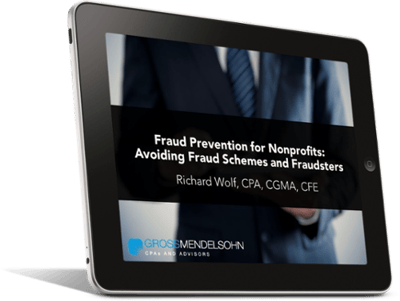When it comes to fraud, the easiest path is the road most traveled, and in the nonprofit sector, expense reimbursement schemes are often the easiest avenue to navigate. Ranging from fraud amounts of a few dollars to thousands of dollars, fraudsters may begin by justifying this scheme as a white lie, which, more often than not, escalates as time goes on.
In my webinar, Fraud Prevention for Nonprofits: Avoiding Fraud Schemes and Fraudsters, I discuss some common fraud schemes nonprofits face and ways to prevent them. We already discussed billing schemes and check tampering on our blog. This article focuses on reimbursement schemes — what they are, and how to detect and prevent them.
What Are the Types of Expense Reimbursement Schemes?
Expense reimbursement schemes are divided into four principle types:
1. Mischaracterized Expenses
This scheme involves requesting reimbursement for personal expenses by claiming it is business related, such as requesting reimbursement for a weekend dinner with friends.
2. Overstated Expenses
In this instance, the fraudster seeks reimbursement for more than what they expended by altering receipts or over purchasing.
A common avenue for this fraud can be found with fraudsters seeking reimbursement for business travel, in which they overstate expenses (such as handwriting a receipt for $45 for a $9 taxi ride) or alter an existing receipt. Fraudsters may also purchase multiple goods, claim reimbursement and then return the goods for cash or store credit.
3. Fictitious Expenses
In this scheme, the fraudster either creates a fictitious receipt or uses blank receipts from legitimate vendors.
4. Multiple Reimbursements
With multiple reimbursements, the fraudster will submit a single (valid) expense more than one time.
How Do I Catch the Fraudster?
To catch a fraudster in an expense reimbursement scheme, review and analysis of expense accounts is necessary. This includes performing a detailed review of expense reports on a regular basis.
Remember, fraudsters usually don’t look and act like the hardened criminal that we may picture in our heads. They often hold a degree of authority in an organization and may have been getting away with the fraud for a significant period of time.
Therefore, while we’d like to believe all our co-workers are honest and ethical, the amount of fraud that continues to persist in the nonprofit sector suggests otherwise. Blind trust is often the avenue to fraud. Make sure you know the warning signs that an employee may be stealing from your organization.
How Can I Prevent Expense Reimbursement Schemes In My Organization?
Clearly defined expense reimbursement policies and procedures are extremely important when it comes to preventing expense reimbursement schemes. By performing a detailed review of expense reports on a regular basis, the likelihood of expense reimbursement fraud decreases as employees take note that the documents they are submitting will be scrutinized.
Fraud is often the byproduct of lax review and weak internal controls. If employees realize that your organization is not taking the time to review their reimbursement claims, they may try and take advantage of the system.
Need Help?
Our Certified Fraud Examiners and Certified Public Accountants can help put effective fraud prevention and detection tactics into place. Contact us online or call 800.899.4623.


